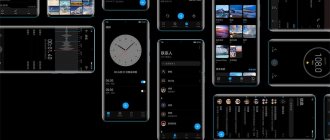We bring to your attention Huawei's view of Wi-Fi 6 - the technology itself and related innovations, primarily in relation to access points: what's new about them, where they will find the most suitable and useful application in 2020, what technological solutions give them the main competitive advantages and how the AirEngine line is generally organized.
What's happening in wireless technology today
During the years when the previous generations of Wi-Fi - the fourth and fifth - were developing, the concept of an all-wireless office, that is, a completely wireless office space, was formed in the industry. But since then, a lot of water has passed under the bridge, and business demands in relation to Wi-Fi have changed qualitatively and quantitatively: bandwidth requirements have increased, reducing latency has become critical, and the further, the more pressing the need to connect a large number of users.
By 2020, a landscape of new applications has emerged that must work reliably over Wi-Fi networks. The illustration shows the main areas to which such applications relate. Briefly about a few of them.
A. Augmented and virtual reality.
For a long time, the abbreviations VR and AR appeared in presentations of telecom vendors, but few people understood what the application of the technologies behind these letters was. Today they are rapidly entering our lives, which is reflected in Huawei products. In April, we introduced the Huawei P40 smartphone and at the same time launched - so far only in China - the Huawei Maps service with the AR Maps function. It is not just “GIS with holograms”. Augmented reality is deeply built into the functionality of the system: with its help, it costs nothing to literally “grab” information about a particular organization whose office is located in the building, plot a route through the surrounding space - and all this in 3D format and with the highest quality.
AR will also definitely see intensive development in the fields of education and healthcare. It is also relevant for production: for example, in order to train employees how to act in emergency situations, it is difficult to come up with something better than simulators in augmented reality.
B. Security systems with video surveillance.
And even broader: any video solution that meets ultra-high definition standards. We are talking not only about 4K, but also about 8K. Leading manufacturers of televisions and information panels promise that models producing 8K UHD images will appear in their product range throughout 2020. It is logical to assume that end users will also want to watch videos in super high quality with a significantly increased bitrate.
B. Business verticals,
and first of all retail. As an example, let's take Lidl, one of Europe's largest supermarket chains. It is using Wi-Fi in new IoT-enabled scenarios for interacting with consumers, in particular introducing ESL electronic price tags, integrating them with its CRM.
As for large-scale production, the experience of Volkswagen is noteworthy, which has deployed Wi-Fi from Huawei in its factories and uses it to solve a variety of problems. Among other things, the company relies on Wi-Fi 6 to operate robots that move around the factory, scan parts in real time using AR scenarios, etc.
G. "Smart offices"
also represent a huge space for innovation based on Wi-Fi 6. A large number of Internet of Things scenarios for a “smart building” have already been thought out, including for security control, lighting control, etc.
We must not forget that most applications migrate to the cloud, and access to the cloud requires a high-quality, stable connection. This is why Huawei uses the motto and strives to implement the goal of “100 Mbps everywhere”: Wi-Fi is becoming the main means of connecting to the Internet, and regardless of the user’s location, we are obliged to provide him with a high level of user experience.
What applications are compatible with HMS?
After installing the applications, the user will have access to the following programs:
- Huawei Themes;
- Huawei Screen Magazine;
- Huawei Browser;
- Huawei Mobile Cloud.
What is the Tips application on Honor/Huawei and how to disable it
Browser - a browser that is used instead of the missing Chrome. Operated by 200 million people. Most users don't care what to use. But via APK you can also configure Chrome in Russian. Themes allows you to download and install the proposed theme on your phone.
Mobile Cloud is a cloud service that protects the user’s personal information. Users can store audio and video content there. The Huawei Music service has a wide range.
Please note that Huawei Video cooperates with partners who have established important positions in the market. Thanks to this, users can freely view various programs. But Youtube is missing, which, however, can be watched through a browser.
Users will be able to read a variety of books thanks to the Reader service - from classics to popular literature. The information center supports 30 languages in 82 countries and regions around the world. As a bonus, the user can connect smart reminders, which will allow him to be aware of all important events. And as a bonus, the ability to set up push mailings - a new channel of communication with users of web resources. Works even without an Internet connection.
How Huawei proposes to manage your Wi-Fi 6 environment
Currently, Huawei is promoting a ready-made end-to-end Cloud Campus solution, aimed, on the one hand, at helping to manage the entire infrastructure from the cloud, and on the other hand, at serving as a platform for implementing new IoT scenarios, be it building management, equipment monitoring or, for example, if we turn to a case from the field of medicine, monitoring the patient’s vital parameters.
An important part of the ecosystem around Cloud Campus is the marketplace. For example, if a developer has created an end device and integrated it with Huawei solutions by writing the appropriate software, he has the right to make his product available to our other customers using a service model.
Since the Wi-Fi network essentially becomes the foundation for business operations, the old ways of managing it are not enough. Previously, the administrator was forced to figure out what was going on with the network almost manually, digging through the logs. This reactive mode of support is now in short supply. Tools are needed for proactive monitoring and management of the wireless infrastructure so that the administrator understands exactly what is happening to it: what level of user experience it provides, whether new users can connect to it without problems, whether any of the clients need to be “transferred” to a neighboring access point (AP), what state each individual network node is in, etc.
For Wi-Fi 6 devices, Huawei has all the tools to proactively, in-depth analyze and control what's happening on the network. These developments are based primarily on machine learning algorithms.
This was not possible on access points of previous series, since they did not support the appropriate telemetry protocols, and in general the performance of those devices did not allow this functionality to be implemented in the form in which our modern access points allow.
What are the advantages of Wi-Fi 6 standard
For a long time, the stumbling block to the spread of Wi-Fi 6 remained the fact that there were de facto no end devices that would support the IEEE 802.11ax standard and could fully realize the advantages inherent in the access point. However, a turning point is taking place in the industry, and we, as a vendor, are contributing to it with all our might: Huawei has developed its chipsets not only for corporate products, but also for mobile and home devices.
— Information about Wi-Fi 6+ from Huawei is circulating on the Internet.
What is this? - It's almost like Wi-Fi 6E. Everything is the same, only with the addition of the 6 GHz frequency range. Many countries are currently considering making it available for Wi-Fi 6.— Will the 6 GHz radio interface be implemented on the same module that currently operates at 5 GHz?
— No, there will be special antennas for operation in the 6 GHz frequency range. Current access points do not support 6 GHz, even if their software is updated.
Today, the devices shown in the illustration belong to the hi-end segment. At the same time, the Huawei AX3 home router, which provides speeds of up to 2 Gbit/s via air interfaces, is no different in price from the previous generation access points. Therefore, there is every reason to believe that in 2020, a wide range of mid-range and even entry-level devices will receive Wi-Fi 6 support. According to Huawei’s analytical calculations, by 2022, sales of access points with Wi-Fi 6 support compared to those built on Wi-Fi 5, will be 90 to 10%.
In a year and a half, the era of Wi-Fi 6 will finally arrive.
First of all, Wi-Fi 6 is designed to make the overall wireless network more efficient.
Previously, each station was given a sequential time slot and occupied the entire 20 MHz channel, forcing others to wait for it to send traffic. Now these 20 MHz are cut into smaller subcarriers, combined into resource units, up to 2 MHz, and up to nine stations can broadcast simultaneously in one time slot. This results in a significant increase in the performance of the entire network. We have already said that higher modulation schemes were added to the sixth generation standard: 1024-QAM versus the previous 256. The complexity of encoding thus increased by 25%: if previously we transmitted up to 8 bits of information per character, now it is 10 bits .
The number of spatial streams has also increased. In previous standards there were a maximum of four, while now there are up to eight, and in older Huawei access points up to a dozen.
In addition, Wi-Fi 6 again uses the 2.4 GHz frequency range, which makes it possible to relatively inexpensively produce chipsets for end terminals supporting Wi-Fi 6 and connect a huge number of devices, be they full-fledged IoT modules or some very cheap ones sensors
What is especially important is that the standard implements many technologies for more efficient use of the radio spectrum, including the reuse of channels and frequencies. First of all, Basic Service Set (BSS) Coloring is worthy of mention, which allows you to ignore other people's access points operating on the same channel, and at the same time “listen” to your own.
First look at the Huawei Honor 6 Plus smartphone: Chinese varieties of apples
Huawei is one of those companies that is not shy. They are not shy about loudly boasting about numbers and small technical details, inviting Chinese actors and popular singers, albeit only in China, to the stage, and also publicly naming the names of competitors. At the presentation of the new flagship Honor, the iPhone 6 and 6 Plus, Samsung Galaxy S5 and Galaxy Note 4 were mentioned (and shown on the screen). And Honor 6 Plus, according to the information presented, was, naturally, better. In everything.
In China, Honor is a separate brand - these devices do not even mention parent Huawei. Honor's target audience is young people, and it is sold exclusively online. In other countries, Honor smartphones come out with the Huawei logo, but the parent company in any case tries to make differences: in general, Huawei may be elite (like the sapphire-ceramic Ascend P7 for 50,000 rubles), but Honor is always one of the most affordable offers in its class .
We reviewed Honor 6 not long ago, and in terms of price-to-features ratio, it really turned out to be one of the best smartphones in the mid-price range. Honor 6 Plus is a step above and no less impressive.
Let's start with the fact that the Honor 6 Plus has a large screen, but the device itself is relatively small. The 5.5-inch matrix fits into a case measuring 150.4 × 75.7 mm and 7.5 mm thick. The device weighs 165 grams. It was not possible to repeat the Mate 7 record, in which the screen occupies 83% of the device’s area, in the case of Honor 6 Plus: here this ratio is 78.2%, which is also, in general, not bad. For the iPhone 6 Plus, for comparison, it is 71.1%, but the frames there look downright thick. On the Honor 6 Plus, the frames are, of course, visible, but they cannot be called wide.
The screen, by the way, is promised to be of very high quality: an IPS matrix with Full HD resolution, with high (it is not specified how much) brightness and a contrast ratio of 1500:1. As we know from the Mate 7, Huawei knows how to put good displays in its smartphones, so the Honor 6 Plus can also count on a very high-quality matrix. We did not have access to a colorimeter at the event in Beijing, so we will have to limit ourselves to subjective assessments. The display is really bright - at least brighter than the Sony Xperia Z2 - and has enough contrast: black does not look dark gray. The colors are saturated, as they like in continental Asia, the color temperature, as far as we can judge by eye, is close to the reference one.
The design of Huawei Honor 6 was developed in France - by specialists from the company's French office. According to the next video - and at least a dozen of them were shown at the presentation - one of the designers used to work at Christian Dior, and the other worked on the appearance of cars. By the way, there are no Chinese among the designers - they are entirely European.
Honor 6 Plus is covered with glass panels on both sides. Again, without hesitation, at the presentation, a Huawei representative reminded that Apple also once made smartphones covered with glass on both sides, but now for some reason they have forgotten how cool it is. Note that the back panel of the iPhone 4 and 4s could not boast of strength - the glass often cracked or even broke. Huawei Honor 6 Plus has a composite back panel, and among other things, it has a layer of some “military material” (probably Kevlar). To demonstrate its strength, those present were shown a video where a stern Huawei employee shoots a smartphone with an air rifle: surprisingly, it does not shatter into pieces - a decent dent remains in the body, but the device supposedly continues to work. The bullet bounces off. We did not check this ourselves - for various and understandable reasons.
The back panel and side metal walls are used to dissipate heat, and a graphite heat exchanger in contact with the SoC transfers this heat to them. Of course, here on stage they again remember the iPhone 6 Plus - it also has a graphite layer, but of a smaller area. According to Huawei's measurements, the smartphone practically does not heat up: when working on the Internet or in 3D games, it did not heat up above 40 degrees.
The Honor 6 Plus, as we have already said, uses two rear cameras. Both are based on 8-megapixel sensors and equipped with exactly the same optics. The pixel size is 1.98 microns, and this is really serious. For comparison, we again present the data of the latest iPhones: they have 1.5 microns - and this is considered a fairly large pixel, that is, it captures a lot of light. Honor 6 Plus also has a front camera – also 8 megapixels.
The two rear cameras, interestingly, are not even used for taking 3D photos, but to improve the quality of the 2D picture and implement all sorts of effects like changing the focusing distance or depth of field after the fact - after taking the picture. Also, the presence of two cameras made it possible, using software processing, to somehow increase the lens aperture from ƒ/2.0 to ƒ/0.95 - Honor 6 Plus allows you to take photos with the appropriate depth of field, that is, with a truly blurred background - for this in the camera menu a special mode is provided. In general, the quality of the photos is very high: in conditions of not the best lighting in the hall of 751 Park Beijing, the smartphone takes low-noise pictures with normal colors - and this is worth a lot.
Changing the depth of field on an already taken frame
Example photo on Huawei Honor 6 Plus
Over time, they promise to implement support for 3D shooting (though with such low parallax, 3D should be very questionable) and provide an SDK for users who want to develop applications for a dual camera. Both cameras are completely recessed into the body, next to them is a dual LED flash.
The Honor 6 Plus uses a Huawei-made SoC and modem. The role of the SoC is played by the eight-core HiSilicon Kirin 925 chip, already familiar from Ascend Mate 7, with four ARM Cortex-A15 and four Cortex-A7 cores: the former operate at a frequency of 1.8 GHz, the latter at 1.3 GHz. This is the correct implementation of the big.LITTLE ideology - the processor allows you to use any number of cores and combine the load on weak and powerful cores depending on the needs of the application. To process sensor data, a separate coprocessor called i3 with a frequency of 230 MHz is used. The role of the graphics accelerator is assigned to the Mali-T628MP4.
The Kirin 925 chip is made using the 28 nm HPM process - HiSilicon has not yet reached more modern production standards, but even within the framework of the existing chips, it turns out to be quite economical. The volume of LPDDR3 RAM is 3 GB - and for this, in our opinion, the creators of a smartphone in the mid-high price category should be praised separately: usually such a volume is the prerogative of expensive devices; you will not find it in the middle segment. And modern applications have serious appetites for memory. The capacity of the built-in eMMC storage is 16 or 32 GB. Available storage space can be expanded with MicroSD cards up to 128 GB.
The modem built into the Kirin 925 is different in that it allows the Honor 6 Plus to work with two SIM cards, both of which are active and both support 4G Cat networks. 6 - that is, they can receive data at speeds of up to 300 Mbit/s. True, support for LTE and 2 SIM is only available in one version of Honor 6 Plus - the oldest, and the user will still have to choose: either a second SIM or memory expansion using MicroSD - Huawei has implemented its favorite patented MicroSIM / MicroSD connector in the smartphone. In versions with one SIM, the second slot will be allocated for MicroSD cards without options.
In addition to this, Honor 6 has a full set of wireless interfaces: Wi-Fi, Bluetooth, NFC and even IR, the tiny transmitter of which is located on the top edge. And if Bluetooth here is quite modern - 4.0, then Wi-Fi, for unknown reasons, can be said to be old - 802.11ac is not supported, only 802.11b/g/n is available. But the module can operate not only at a frequency of 2.4 GHz, but also at 5 GHz, so there should not be any serious problems with the data transfer speed via Wi-Fi.
Let's finish the story about the technical characteristics with information about the battery: 12.5 Wh (3300 mAh, 3.8 V). The Mate 7, with its 15.6 Wh battery and slightly larger screen, was completely impossible to drain in a day. Most likely, the Honor 6 Plus battery will be enough to work throughout the day - almost no one demands more from a modern smartphone. Finally, one more small technical feature: the MicroUSB port (which, by the way, supports OTG) in Honor 6 Plus can charge all kinds of small equipment, that is, the smartphone can be used as an external battery - given the size of its battery, this is quite important. But what we haven’t seen before is the ability to charge the battery of headphones with active noise cancellation via a 3.5 mm audio jack - this is also provided in the Honor 6 Plus.
Now we’ll tell you about a couple of Chinese miracles that, unfortunately, will not appear in Russia. Miracle one: Honor Pay is a payment system using NFC. Currently, you can pay by tapping your phone on the terminal for rides on the Chinese subway and snacks at a Chinese Starbucks. In our country there are analogues of Honor Pay, but in order to get all the delights of paying for coffee using your phone, you either need to turn to third-party applications that create a virtual card - in general, you will have to suffer a little. It will not be possible to pay for the Moscow metro in any case, although the capital’s government was going to introduce this option in test mode starting in December.
The second miracle: the SkyTone soft SIM card embedded in the Kirin 925. With its help, Huawei offers its compatriots to use data transfer while roaming at non-roaming rates. Prices promise to be more than affordable: 5 yuan (about 50 rubles at the time of writing this article) for 20 MB of traffic or 28 yuan per day of unlimited Internet access. True, SkyTone is offered only to owners of the most expensive version with two 4G SIM cards. Honor users also have access to 8 million Wi-Fi hotspots at airports and hotels around the world for free.
Honor 6 Plus runs Android 4.4, dressed in the EMUI 3.0 shell, already familiar to users of modern Huawei devices. Let us remind you that this version of Emotion UI, among other things, accepts gestures when the screen is turned off, and in terms of interface design it is in some places reminiscent of the latest versions of iOS. And here, for some reason, comparisons with iPhones are not heard from the stage.
The cost of the older version of Honor 6 Plus - with two SIM cards and a 32 GB drive - in China will be 2,499 yuan (approximately 25,000 rubles at the time of writing this article). A simpler version - with one SIM card and 16 GB of memory - will cost 1,999 yuan (about 20,000 rubles). Note that smartphones in China are quite expensive. Let's say, in a market like our “Gorbushka” they ask for 4,499 yuan for the Sony Xperia Z3 Compact. So the announced prices place the Honor 6 Plus in the middle class - and for a middle-class device it really turned out to be extremely promising. Only one question remains: will Honor 6 Plus be available in Russia - and at what prices.
Which Wi-Fi 6 access points from Huawei do we think should be done first?
The pictures show the access points that Huawei offers today and, most importantly, which it will soon begin to supply, starting with the basic AirEngine 5760 model and ending with the top ones.
Our access points that support the 802.11ax standard implement a whole range of unique technological solutions.
- Availability of a built-in IoT module or the ability to connect an external one.
At all access points, the top cover now opens, and underneath it are hidden two slots for IoT modules, almost any kind. For example, from ZigBee, suitable for connecting smart sockets or relays, telemetry sensors, etc. Or specialized ones, for example, for working with electronic price tags (Huawei has implemented such a solution in partnership with Hanshow). Plus, some series access points have an additional USB connector, and the Internet of Things module can be connected through it. - New generation of Smart Antenna technology.
The access point housing houses up to 16 antennas, forming up to 12 spatial streams. Such “smart antennas” make it possible, in particular, to increase the coverage radius (and get rid of “dead zones”) due to the fact that each of them has a focused range of radio signal propagation and “understands” where a specific spatial location is located at one time or another client. - A larger signal propagation radius
means that the client’s RSSI, or received signal strength, will also be higher. In comparative tests, when a regular omni-directional access point and one equipped with smart antennas are tested, the second has a twofold increase in power - an additional 3 dB
When using smart antennas, there is no signal asymmetry, since the sensitivity of the access point increases proportionally. Each of the 16 antennas acts as a mirror: due to the principle of multipath propagation, when a client sends a beam of information, the corresponding radio wave, reflected from various obstacles, hits all 16 antennas. Then the point, using its internal algorithms, adds the received signals and restores the encoded data with a greater degree of reliability.
- All new Huawei access points implement SDR (Software-Defined Radio) technology.
Thanks to it, depending on the preferred scenario for operating the wireless infrastructure, the administrator determines how the three radio modules should operate. How many spatial streams to allocate to one or another is also determined dynamically. For example, you can make two radio modules work to connect clients (one in the 2.4 GHz range, the other in the 5 GHz range), and the third one functions as a scanner, monitoring what is happening with the radio environment. Or use three modules exclusively for connecting clients.Another common scenario is when there are not too many clients on the network, but their devices run high-load applications that require high bandwidth. In this case, all spatial streams are tied to the frequency ranges of 2.4 and 5 GHz, and the channels are aggregated to provide users with not 20, but 80 MHz bandwidth.
- The access points implement filters in accordance with 3GPP specifications
in order to separate radio modules that could potentially operate at different frequencies in the 5 GHz range from each other, in order to avoid internal interference
Access points provide operation in different modes.
One of them is RTU (Right-to-Use). Briefly, its basic principle is as follows. Models of individual series will be supplied in a standard version, for example with six spatial streams. Further, with the help of a license, it will be possible to expand the functionality of the device and activate two more streams, revealing the hardware potential inherent in it. Another option: perhaps, over time, the client will need to allocate an additional radio interface for scanning the airwaves, and in order to put it into operation, it will be enough to purchase a license again. In the lower right part of the previous illustration, the access points have digital correspondences, for example 2+2+4 in relation to the AirEngine 5760. The point is that the AP has three independent radio modules. The numbers show how many spatial streams will be assigned to each radio module. Accordingly, the number of threads directly affects the throughput in a given range. The standard series provides up to eight streams. Advanced - up to 12. Finally, flagship (hi-end devices) - up to 16.
How to remove Huawei Mobile Services
If you decide that your Huawei account is no longer useful, then you need to go to “Settings” / “Login via Huawei account” / “Privacy” / “Delete account”.
Please note that after deletion, personal data will be deleted from the server without the possibility of recovery. And backup data is deleted after 6 months.
If you do not find the “Delete account” item, then open the Google Play application store and update Huawei Mobile Services, repeat the transition. The market situation with the company's phones somewhat puzzled users who began to doubt the rationality of their use. But the hard work of Chinese developers, their perseverance and originality convince us that American sanctions are not only not an obstacle, but an excellent motivation for development.
How the AirEngine line works
From now on, the common brand of corporate wireless solutions is AirEngine. As you can easily see, the design of the access points is inspired by aircraft engine turbines: special diffusers are placed on the front and rear surfaces of the devices.
The initial series AirEngine 5760-51 devices are the most accessible to consumers and are designed for the most common scenarios. For example, for retail. However, they are quite suitable for office needs, being universal in terms of the technology stack used in them and cost.
The next oldest series is 5760-22W. It includes wall-plate access points, which are not suspended from the ceiling, but are placed on a table, in a corner or attached to the wall. They are best suited for those scenarios in which it is necessary to cover a large number of relatively small rooms with wireless communication (in a school, hospital, etc.), where a wired connection is also needed.
The 5760-22W (wall-plate) model provides a 2.5 Gbit/s connection via copper interfaces, and also has a special SFP transceiver for PON. Thus, the access layer can be completely implemented over a passive optical network and the access point can be connected directly to this GPON network.
The range includes both internal and external access points. The latter are easily distinguished by the letter R (outdoor) in the name. Thus, the AirEngine 8760-X1-PRO is designed for indoor use, while the AirEngine 8760R-X1 is designed for outdoor scenarios. If the name of the access point contains the letter E (external), it means that its antennas are not built-in, but external.
The top model - AirEngine 8760-X1-PRO is equipped with three ten-gigabit interfaces for connection. Two of them are copper, and both support PoE / PoE-IN, which allows you to reserve the device for power. The third is for fiber optic connection (SFP+). Let us clarify that this is a combo interface: it is possible to connect via both copper and optics. Also, let’s say, nothing prevents you from connecting an access point via optics, and providing power from the injector via a copper interface. We should also mention the built-in Bluetooth 5.0 port. The 8760-X1-PRO has the highest performance in the line, since it supports up to 16 spatial streams.
— Do PoE+ access points have enough power?
— For the older series (8760) POE++ is required. That is why CloudEngine s5732 switches with multi-gigabit ports and support for 802.3bt (up to 60 W) go on sale in May-June.
Moreover, the AirEngine 8760-X1-PRO receives additional cooling. Liquid circulates through two circuits inside the access point, removing excess heat from the chipset. This solution is primarily designed to ensure long-term operation of the device with peak performance: some other vendors declare that their access points are also capable of delivering up to 10 Gbps, however, after 15–20 minutes these devices are prone to overheating, and for the sake of reducing their temperature, part of the spatial flows is turned off, which reduces throughput.
The lower series access points do not have liquid cooling, but they do not have the problem of overheating due to lower performance. Mid-level models - AirEngine 6760 - support up to 12 spatial streams. They also connect via ten-gigabit interfaces. In addition, there is a gigabit one - for connecting to existing switches.
For a relatively long time now, Huawei has been offering an Agile Distributed Wi-Fi solution, which involves the presence of a central access point and remote radio modules controlled by it. Such an AP is responsible for various kinds of high-load tasks and is equipped with a CPU to implement QoS, make decisions about client roaming, limit bandwidth, recognize applications, etc. In turn, external radio modules actually send traffic in its original form to the central access point and perform converters from 802.11 to 802.3.
The decision turned out to be not very popular in Russia. Nevertheless, one cannot fail to note its advantages. For example, it’s possible to save a lot on the cost of licenses, since you don’t need to buy a separate one for each radio module. In addition, the main load falls on central access points, which makes it possible to deploy a huge wireless network consisting of tens of thousands of elements. So we've updated Agile Distributed Wi-Fi to take advantage of our technology stack around Wi-Fi 6.
Outdoor access points will also be available in June. The senior series among outdoor devices is the 8760R, with the maximum technology stack (in particular, up to 16 spatial streams are available). However, we assume that for most scenarios the 6760R will be the optimal choice. Street coverage, as a rule, is required either in warehouses, or for wireless bridging, or at technological sites, where periodically there is a need to receive or transmit some telemetry or collect information from data collection terminals.
About the technological advantages of AirEngine access points
Previously, the variability of external antennas for our access points was extremely limited. There were either omni-directional (dipole) antennas, or very narrowly directional ones. Now the choice is wider. For example, an antenna 70° / 70° in azimuth and elevation saw the light. By placing it in the corner of the room, you can cover almost the entire space in front of it with a signal.
The list of antennas supplied with indoor access points is growing, and it is possible that more will be added, including those produced by other manufacturers. Let's make a reservation: there are no directed ones among them. If you need to organize coverage focusing indoors, you need to either use models with external dipole antennas and position them yourself for optimal radio signal propagation, or take access points with built-in smart antennas.
There are no significant changes regarding the installation of access points. All models are equipped with fastenings for mounting both on the ceiling and on the wall or even on a pipe (metal clamps). The fastenings are also suitable for office ceilings with Armstrong type roof rails. Additionally, you can install locks, which is especially important if the access point will operate in a public place.
If you take a quick look at the key technological innovations that were implemented during the development of the AirEngine model range, you will get the following list.
- The highest productivity in the industry has been achieved. To date, only Huawei has managed to implement 16 receiving and transmitting antennas with 12 spatial streams in one access point. Smart antenna technology in the form in which it is implemented by Huawei is also not available to any other company at the moment.
- Huawei has special solutions to achieve ultra-low latency. This allows, in particular, completely seamless roaming for mobile warehouse robots.
- As you know, Wi-Fi 6 technology includes two solutions for multiple access: OFDMA and Multi-User MIMO. No one except Huawei has yet managed to organize their simultaneous operation.
- Internet of Things support for AirEngine access points is unprecedentedly broad and native.
- The line meets the highest safety standards. Thus, all our Wi-Fi 6 points implement encryption based on the WPA3 protocol.
What determines the throughput of an access point? According to Shannon's theorem, from three factors:
- on the number of spatial streams;
- on the bandwidth;
- on the signal-to-noise ratio.
Huawei solutions in each of the three named areas differ from what other vendors offer, and each contains many improvements.
- Huawei devices are capable of generating up to twelve spatial streams, while top-end access points from other manufacturers have only eight.
- Huawei's new access points are able to generate eight spatial streams with a width of 160 MHz each, while competing vendors have a maximum of eight streams of 80 MHz. As a result, one and a half or even two times the performance superiority of our solutions is potentially achievable.
- As for the signal-to-noise ratio, due to the use of Smart Antenna technology, our access points demonstrate significantly greater tolerance to interference and a much higher level of RSSI at the client's reception - at least twice as much (by 3 dB).
Let's figure out where the bandwidth comes from, which is usually indicated in datasheets. In our case - 10.75 Gbit/s.
The calculation formula is shown in the figure above. Let's see what the multipliers in it are.
The first is the number of spatial streams (at 2.4 GHz - up to four, at 5 GHz - up to eight). The second is a unit divided by the sum of the symbol duration and the duration of the guard interval in accordance with the standard used. Since in Wi-Fi 6 the symbol duration is quadrupled to 12.8 μs, and the guard interval is 0.8 μs, the result is 1/13.6 μs.
Next: as a reminder, thanks to improved 1024-QAM modulation, up to 10 bits can now be encoded per symbol. In total, we have a bitrate of 5/6 (FEC) - the fourth multiplier. And the fifth is the number of subcarriers (tones).
Finally, adding up the maximum performance for 2.4 and 5 GHz, we get an impressive value of 10.75 Gbps.
DBS radio frequency resource management has also appeared in our access points and controllers. If previously you had to select the channel width for a particular SSID once (20, 40 or 80 MHz), now it is possible to configure the controller so that it does this dynamically.
Another improvement in the distribution of radio resources was brought by SmartRadio technology. Previously, if there were several access points in one zone, it was possible to specify by what algorithm to redistribute clients, to which AP to connect a new one, etc. But these settings were applied only once, at the time of its connection and association with the Wi-Fi network. In the case of AirEngine, algorithms for load balancing can be applied in real time while clients are working and, for example, moving between access points.
An important nuance regarding antenna elements: in AirEngine models they simultaneously implement both vertical and horizontal polarization. Each one supports four antennas, and there are four such elements. Hence the total number - 16 antennas.
The antenna element itself is passive. Accordingly, in order to focus more energy in the direction of the client, it is necessary to form a narrower beam using compact antennas. Huawei succeeded. The result is radio coverage on average 20% greater than that of competing solutions.
With Wi-Fi 6, ultra-high throughput and high modulation levels (MCS 10 and MCS 11 schemes) are only possible when the signal-to-noise ratio, or Signal-to-Noise Ratio, exceeds 35 dB. Every decibel counts. And the smart antenna really allows you to increase the level of the received signal.
In real tests, 1024-QAM modulation with the MCS 10 scheme will work at a distance of no more than 3 m from the access point, whichever one is available on the market. Well, when using a “smart” antenna, the distance can be increased to 6–7 m.
Another technology that Huawei has integrated into the new access points is called Dynamic Turbo. Its essence lies in the fact that the AP can recognize and classify applications on the fly by class (for example, it transmits real-time video, voice traffic or something else), distinguish clients according to their degree of importance and allocate resource units in such a way to ensure that high-level applications that are important to users run as quickly as possible. In fact, at the hardware level, the access point performs DPI - deep traffic analysis.
As noted earlier, Huawei is currently the only vendor that provides simultaneous operation of MU-MIMO and OFDMA in its solutions. Let's take a little more detail about the difference between them.
Both technologies are designed to provide multi-user access. When there are many users in the network, OFDMA allows the frequency resource to be distributed so that many clients receive and receive information at the same time. However, MU-MIMO ultimately aims at the same thing: when several clients are located at different points in the room, each of them can be sent a unique spatial flow. For clarity, let’s imagine that the frequency resource is the Moscow-St. Petersburg route. OFDMA seems to be suggesting: “Let’s make the road not one lane, but two, so that it can be used more efficiently.” MU-MIMO has a different approach: “Let’s build a second, third road so that traffic goes along independent paths.” Theoretically, one does not contradict the other, but in reality, a combination of two methods requires a certain algorithmic basis. Thanks to the fact that Huawei was able to create this base, the throughput of our access points has increased by almost 40% compared to what competitors are able to provide.
Regarding security, the new access points, like previous models, support DTLS. This means, as before, CAPWAP control traffic can be encrypted.
With protection from external malicious influences, everything is the same as in the previous generation of controllers. Any type of attack, be it brute force, Weak IV attack (weak initialization vectors) or something else, is detected in real time. The reaction to DDoS is also configurable: the system can create dynamic blacklists, notify the administrator about what is happening when attempting a distributed network attack, etc.
What does HMS contain?
On the user side, HMS offers many services that aim to replace GMS. The most significant of them is AppGallery, an alternative to the Google Play store. Below is a list of all the major services that HMS offers.
Huawei ID
The first and foremost requirement for using HMS is Huawei ID. Just like an Apple ID or Google account, Huawei ID allows you to configure and save device settings. Some of your personal data, including contacts, messages, Wi-Fi passwords, is synced with your ID.
Huawei Mobile Cloud
Huawei Mobile Cloud works in sync with Huawei ID to give you access to all your device data in one place. Essentially, this is where things like photos, videos, contacts, calendars, notes, and more are stored. Each user receives 5 GB of cloud storage for free, after which it can be expanded up to 2 TB for a fee. To view all your data from your PC, you need to go to cloud.huawei.com.
Huawei Assistant
Global versions of Honor 9X Pro, Huawei Mate XS and Honor View 30 Pro are equipped with a virtual assistant that replaces the main functions of Google Assistant. This greatly simplifies the search for information and the availability of applications. In addition, there is a SmartCare tool that provides access to contextual maps for stocks and sports, covering 150 sporting events and more than 150 stock markets. All future devices running EMUI 10 or higher will come with a digital assistant.
Huawei themes
Huawei Themes is an HMS theme app that allows you to personalize your phone with different themes, fonts, icons, lock screens and wallpapers.
Huawei Music
It is its own music streaming service. The company has not talked much about it until now, since it is not currently available in all Huawei markets. The official page of the service says that it will host music from popular artists. In addition, recommendations are promised according to different genres, moods, regions and much more. The party feature will allow users to play the same music track simultaneously on different devices for shared listening.
Huawei Video
A video streaming service that is available on devices running EMUI 5 or higher. At the moment the service only works in Italy and Spain. Huawei Video features European and Spanish series, short videos, sports videos, feature films and documentaries.
Huawei Browser
The name of this tool speaks for itself. This application is designed for surfing the Internet. The browser comes pre-installed with an integrated news feed and supports dark mode.
What solutions accompany AirEngine models
Our CampusInsight Wi-Fi 6 analytics platform solves several problems. First of all, it is used in radio management along with the controller: CampusInsight allows you to perform calibration and in real time best distribute channels, adjust the signal strength and bandwidth of a particular channel, and control what is happening with the Wi-Fi network. With all that, CampusInsight is also applicable in wireless security (in particular, for intrusion prevention and intrusion detection), and not in relation to a specific access point or one SSID, but on the scale of the entire wireless infrastructure.
WLAN Planner is also worthy of attention - a tool for radio modeling, and it can independently determine some obstacles, such as walls. At the output, the program produces a short report, which, among other things, indicates how many access points are required to cover the room. Based on such input, it is much easier to make more informed decisions regarding equipment specifications, budgeting, etc.
Among the software, we also mention the Cloud Campus App, available to everyone on both iOS and Android and containing a whole set of tools for monitoring a wireless network. Some of them are designed to test the quality of Wi-Fi (for example, roaming test). Among other things, you can evaluate the signal level, find sources of interference, check the throughput in a particular area, and if there are problems, identify their causes.
Huawei AppGallery
This is an alternative to the Google Play store for Huawei and Honor smartphones. The Chinese company has invested more than a billion dollars in creating applications for AppGallery. According to the latest data, the store has more than 400 million monthly users. This information was announced by Huawei itself and so far no third-party research organization has confirmed or denied this data, so it is better to take it with a grain of salt.
Apps in the store are currently divided into 18 categories, including news, social media, entertainment and more. Users can already find Snapchat, TikTok, Deezer, Amazon, Amazon Prime Videos, Booking.com, The Financial Times, BBC News and others there. In addition, there are several popular games there.
Unfortunately, apps like Facebook's Telegram, WhatsApp, Instagram, Netflix and others are still missing from the Huawei app store. However, at least some of them will appear on the AppGallery soon.
Obviously, you shouldn't expect YouTube, Gmail, Google Photos, Google Maps, Drive, etc. there. All these apps will not be available on Huawei and Honor smartphones until the US ban is lifted, provided Google is willing to publish them on a rival store.
Huawei says that if users can't find an app in the AppGallery, they can wishlist the unfound one. They can then receive a notification as soon as it appears on the Huawei Store. One of the distinguishing features of AppGallery is its support for Quick Apps, an analogue of Google's instant apps that do not require installation.
In addition to developing AppGallery, Huawei is said to be working with Xiaomi, Vivo and Oppo to create a unified app download service that will make it easier for developers to distribute their apps to device users from these four manufacturers. Currently there is quite a bit of information about this initiative.
***
Huawei experts continue to regularly conduct webinars on our new products and technologies.
Topics include: principles of building data centers using Huawei equipment, specifics of operating Dorado V6 arrays, AI solutions for various scenarios, and much, much more. You can find a list of webinars for the coming weeks by following the link. We also invite you to check out the Huawei Enterprise Forum, where not only our solutions and technologies are discussed, but also broader engineering issues. It also has a thread on Wi-Fi 6 - join the discussion!
Composition of HMS
In the future, with development, the number of components may increase.
- Huawei ID is an account where all your personal data, contacts, messages, Wi-Fi passwords will be synchronized.
- Mobile Cloud is a cloud that works with an active account. Supports backup of photos, videos, contacts, calendar data, notes, etc. 5 GB is given free of charge, can be expanded up to 2 TB. You can view backup data by logging into cloud.huawei.com.
- Assistant is a virtual assistant that allows you to easily view a list of installed software, notes, email messages, and calendar entries. There are also personalized news from different sources.
- Themes - design themes, fonts, icons, lock screen, wallpaper can be unique.
- Music - listen to music online, there is a paid subscription of one month and a free trial period. Alternative to Apple Music and Google Play Music.
- Video is the default video player. According to the Google store, it supports online video streaming services, but for now only in Spain and Italy (there will be more countries in the future). Most online content is paid, some is free, and there is also a movie rental area.
- Browser - browser, voice commands are supported.
- AppGallery is a software store, popular software is of course present, but for example, a local application for pizza delivery or ordering a taxi is not always possible to find. However, it is worth noting that applications such as Snapchat, TikTok, Deezer, Amazon, Amazon Prime Videos are available, but Facebook, WhatsApp and Instagram are not. The company states that if the desired program is not available, it can be added to the wish list, so the more users add to the list, the more likely it is that it will appear in the future. There is a proprietary Quick Apps technology - fast applications that do not require installation, use little RAM, but work as their own, there are currently 1700 such applications in total, the number is constantly growing.
The absence of Facebook, WhatsApp and Instagram is a serious disadvantage, but I hope that in the future the company will be able to fix this.
An account, like in Google, is the main and first thing you need to create for the services to work:











